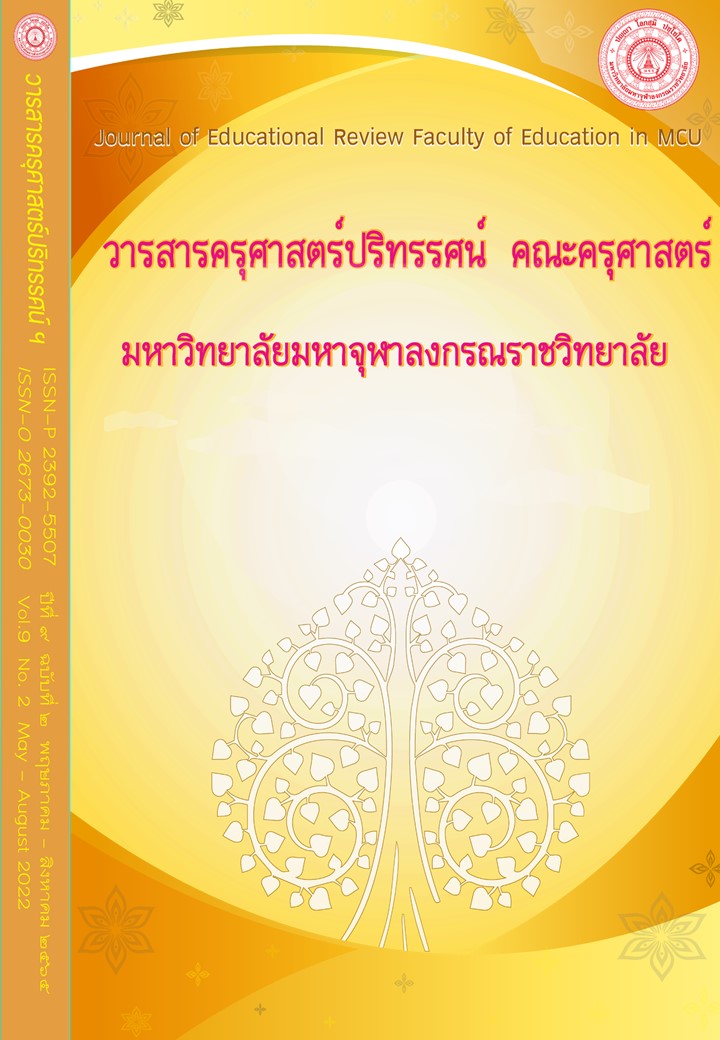THE PRIORITY NEEDS OF ACADEMIC MANAGEMENT OF SECONDARY SCHOOLS IN SUVARNABHUMI PRAKAN CONSORTIUM BASED ON THE CONCEPT OF SOCIAL ENTREPRENEUR CHARACTERISTICS
Main Article Content
Abstract
The purpose of this research were 1) to study the actual state and the desirable state of academic management of secondary schools in suvarnabhumi prakan consortium based on the concept of social entrepreneur characteristics and 2) to analyze the priority needs of academic management of secondary schools in suvarnabhumi prakan consortium based on the concept of social entrepreneur characteristics. The sample population of the research were 7 secondary schools in suvarnabhumi prakan consortium and the informants consisted of 260 people using the tables of Krejcie and Morgan. The research instrument in this study was the 5 - point rating scaled questionnaire of the actual state and the desirable state of academic management of secondary schools in suvarnabhumi prakan consortium based on the concept of social entrepreneur characteristics. The data were analyzed by frequency distribution, percentage, mean, standard deviation and modified priority needs index. The research findings indicated that, overall, the actual state was at the high level and was sorted from the highest to the lowest as follows: the instructional management, the measurement and evaluation, the development and promotion of learning resources and the curriculum development respectively. The desirable state was, overall, at the highest level and was sorted from the highest to the lowest as follows: the instructional management, the development and promotion of learning resources, the measurement and evaluation and the curriculum development respectively. The result of priority need analysis turned out that the first priority need fell on development and promotion of learning resources, followed by measurement and evaluation, curriculum development and instructional management, respectively.
Article Details

This work is licensed under a Creative Commons Attribution-NonCommercial-NoDerivatives 4.0 International License.
ทัศนะและความคิดเห็นที่ปรากฏในบทความในวารสารฉบับนี้ถือเป็นความรับผิดชอบของผู้เขียนบทความนั้นเพียงผู้เดียว และไม่ถือเป็นทัศนะและความรับผิดชอบของกองบรรณาธิการ
กองบรรณาธิการขอสงวนสิทธิ์ในการคัดเลือกบทความลงตีพิมพ์และจะแจ้งให้เจ้าของบทความทราบหลังจากผู้ประเมินบทความตรวจอ่านบทความแล้ว
ต้นฉบับที่ได้รับการตีพิมพ์ในวารสารครุศาสตร์ปริทรรศน์ คณะครุศาสตร์ มหาวิทยาลัยมหาจุฬาลงกรณราชวิทยาลัย ถือเป็นกรรมสิทธิ์ของคณะครุศาสตร์ มหาวิทยาลัยมหาจุฬาลงกรณราชวิทยาลัย ห้ามนำข้อความทั้งหมดหรือบางส่วนไปพิมพ์ซ้ำ เว้นเสียแต่ว่าจะได้รับอนุญาตจากมหาวิทยาลัยฯ เป็นลายลักษณ์อักษร
References
กรมวิชาการ กระทรวงศึกษาธิการ. (2546). หลักสูตรการศึกษาขั้นพื้นฐาน พุทธศักราช 2542 และที่แก้ไขเพิ่มเติม (ฉบับที่ 2) พุทธศักราช 2545. กรุงเทพมหานคร: องค์การรับส่งสินค้าและพัสดุภัณฑ์.
กระทรวงศึกษาธิการ. (2550). พระราชบัญญัติการศึกษาแห่งชาติ พ.ศ. 2542 แก้ไขเพิ่มเติม (ฉบับที่ 3) พ.ศ. 2553. กรุงเทพมหานคร: พริกหวานกราฟฟิก.
เกรียงศักดิ์ เจริญวงศ์ศักดิ์. (2550). ผู้ประกอบการเพื่อสังคม: ความหวังใหม่ในการพัฒนาสังคมไทย. แหล่งที่มา http://oknation.nationtv.tv/blog/kriengsak. สืบค้นเมื่อ 25 พ.ย. 2563.
นรรัชต์ ฝันเชียร. (2563). สอนนักเรียนให้มีสำนึกรับผิดชอบต่อสังคม. แหล่งที่มา https://www.trueplookpanya.com/blog/content/82917/-blog-teaartedu/. สืบค้นเมื่อ 25 พ.ย. 2563.
ปรียาภรณ์ วงศ์อนุตรโรจน์. (2553). การบริหารงานวิชาการ. กรุงเทพมหานคร: ศูนย์สื่อเสริมกรุงเทพฯ.
เรวัตร ตันตยานนท์. (2560). ผู้ประกอบการเพื่อสังคม และนวัตกรรมเพื่อสังคม. แหล่งที่มา https://www.bangkokbiznews.com/blog/detail/641032. สืบค้นเมื่อ 25 พ.ย. 2563.
สถาบันนักลงทุนรุ่นใหม่. (2563). หลักสูตรสุดยอดผู้ประกอบการยุคใหม่เพื่อสังคม สำหรับผู้บริหาร (SEP-S) รุ่นที่ 12. แหล่งที่มา https://sepsnips.makemoneyclub.com/uploads/1/1/8/2/118212789/project-info_seps12.pdf สืบค้นเมื่อ 25 พ.ย. 2563.
สมาคมธุรกิจเพื่อสังคม. (2562). ธุรกิจเพื่อสังคมคืออะไร. แหล่งที่มา www.sethailand.org. สืบค้นเมื่อ 25 พ.ย. 2563.
สำนักงานคณะกรรมการการศึกษาขั้นพื้นฐาน กระทรวงศึกษาธิการ. (2552). คู่มือการปฏิบัติงานข้าราชการครู.กรุงเทพมหานคร: โรงพิมพ์ชุมนุมสหกรณ์การเกษตรแห่งประเทศไทย.
สำนักงานคณะกรรมการการศึกษาขั้นพื้นฐาน. (2563). นโยบายสำนักงานคณะกรรมการการศึกษาขั้นพื้นฐาน พ.ศ. 2563. กรุงเทพมหานคร: โรงพิมพ์ชุมนุมสหกรณ์การเกษตรแห่งประเทศไทย.
สำนักงานคณะกรรมการการศึกษาแห่งชาติ. (2544). คู่มือการดำเนินงาน เครือข่ายพ่อแม่ ผู้ปกครอง เพื่อปฏิรูปการเรียนรู้. กรุงเทพมหานคร: สำนักพิมพ์วัฒนาพานิช.
สำนักงานเลขาธิการสภาการศึกษา. (2560). แผนการศึกษาแห่งชาติ พ.ศ. 2560 – 2579. กรุงเทพมหานคร:
พริกหวานกราฟฟิก.
สำนักงานศึกษาธิการจังหวัดสมุทรปราการ. (2563). ข้อมูลสารสนเทศด้านการศึกษา จังหวัดสมุทรปราการ
ปีการศึกษา 2563. แหล่งที่มา http://www.prakanedu.go.th. สืบค้นเมื่อ 25 พ.ย. 2563.
สินี จักรธรานนท์. (2557). ‘Ashoka’ องค์กรเปลี่ยนโลกผู้สร้างสรรค์นวัตกรเพื่อมวลชน. แหล่งที่มา https://www.creativemove.com/interview/ashoka/. สืบค้นเมื่อ 25 พ.ย. 2563.
อรรถพล อนันตวรสกุล. (2563). แนวทางและเทคนิคการสอนหน้าที่พลเมือง. แหล่งที่มา https://www.educathai.com/videos/186. สืบค้นเมื่อ 25 พ.ย. 2563.
Anderson et al. (2017). Applying Design Thinking to Curriculum Reform. Academic Medicine. 427.
Brooks, A. C. (2009). Social entrepreneurship: A modern approach to social venture creation. New Jersey: Pearson Prentice Hall.
Carroll, M. (2014). Learning from What Doesn’t Work: The Power of Embracing a Prototyping Mindset. From web.standford.edu/. Retrieved November 24, 2020.
Duening, T.N. (2008). Five Minds for the Entrepreneurial Future: Cognitive Skills as the Intellectual Foundation for Next Generation Entrepreneurship Curricula. Conference of the USA SBE.
Dunne, D., & Martin, R.P. (2006). Design Thinking and How It Will Change Management Education: An Interview and Discussion.
Gallagher, A. and Thordarson, K. (2018). Design Thinking for School Leaders: Five Roles and Mindsets that Ignite positive change. Alexandria, Virginia USA: ASCD.
Gandy, J. D. (2012). The relationship between social entrepreneurship and organizational effectiveness (Doctoral dissertation). Texas, US: Dallas Baptist University.
Graves, C. (2014). What Is a Makerspace. Knowledge Quest. 42(4). 8 - 13.
Gregory Dees. (1998). Social enterprise: Private initiatives for the common good. Harvard Business Review. 54 - 58.
Hawthorne, G. et al. (2014). Impact and sustainability of creative capacity building: the cognitive, behavioral, and neural correlates of increasing creative capacity, in H. Plattner et al. [Eds] Design Thinking Research: Building Innovation Eco-systems. Cham, Switzerland: Springer. 65 – 77.
Kwek. D. (2011). Innovation in the Classroom: Design Thinking for 21st Century Learning. Stanford EDU. From http://www.stanford.edu/group/redlab/cgi-bin/materials/Kwek-Innovation In The Classroom.pdf. Retrieved November 24, 2020.
Leadbeater. (1997). The rise of the social entrepreneur. London: Great Britain.
Mark Richardson. (2009). Global Social Enterprise. From www.britishcouncil.org/society/social-enterprise/. Retrieved November 24, 2020.
Morris, M. H. (1998). Entrepreneurial intensity : Sustainable advantages for individuals, organizations, and societies. Westport, CT.: Quorum Books.
Robert Ashton. (2010). How to be a Social Entrepreneur. From http://www.robertashton.co.uk/. Retrieved November 24, 2020.
Royalty, A., Oishi, L., & Roth, B. (2014). Acting with creative confidence: Developing a creative agency assessment tool. In H. Design thinking research. Building innovation eco systems, Cham: Springer. 79-96.
White House. (2014). President Obama to host first-ever White House Maker Faire. From https://obamawhitehouse.archives.gov/the-pressoffice/2014/06/18/fact-sheet-president-obama-host-first-ever-white-housemaker-faire. Retrieved November 24, 2020.


